Nvidia Statistics By Revenue, Market, Employee, Net Income And Facts (2025)
Updated · Nov 04, 2025
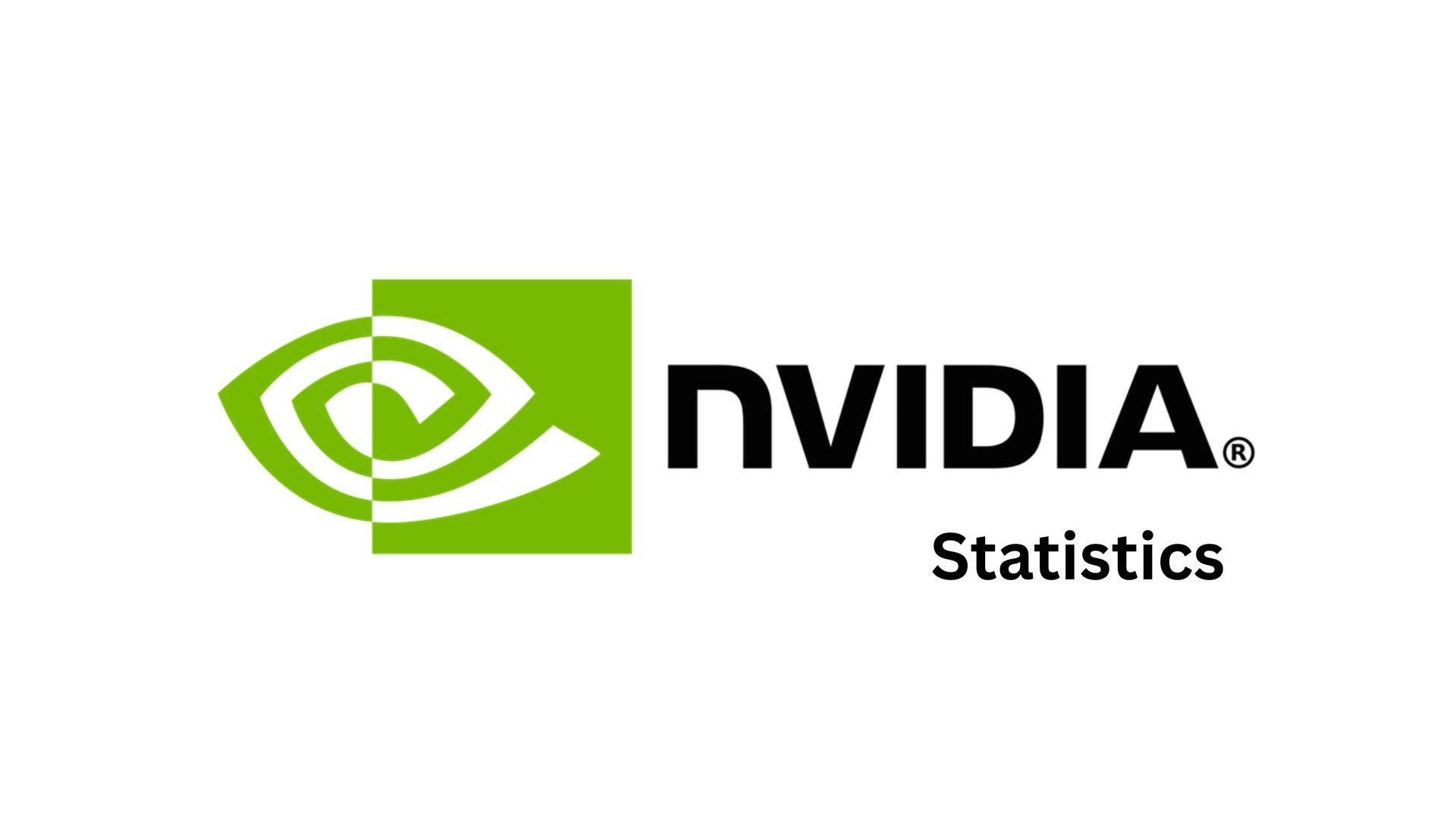
Table of Contents
- Introduction
- Editor’s Choice
- Nvidia Facts
- Nvidia Revenue And Net Income
- Nvidia Market Capitalization
- Nvidia Quarterly Growth Of Revenue And Net Income
- Nvidia Revenue By Segment
- Nvidia Employees
- Nvidia Research And Development
- Nvidia Employees By Location
- Nvidia Workforce By Ethnicity
- Stock Volatility And Trading Volume Data
- Nvidia Earnings Per Share
- Nvidia Stock Price
- Nvidia Major Acquisition
- Nvidia Awards
- Nvidia’s Strong Financial Health
- Nvidia Actual And Expected Earnings
- Institutional Vs. Retail Ownership
- Dividend And Share Buyback
- NVIDIA Insider Confidence And Strategic Growth Highlighted
- NVIDIA’s GPU Roadmap
- Recent Developments
- Conclusion
Introduction
Nvidia Statistics: Nvidia has arguably been a big name since the time it roamed the earth as a graphics chip maker to become the engine of the global AI boom. In 2025, the company had phenomenal increases in revenues, huge, invaluable profits, and a gigantic market valuation that placed it on the list of the very largest companies in the world. This article will break down the important numbers of Nvidia in 2025, in simple and clear language.
This article offers a panoramic view of the latest Nvidia statistics regarding its stock information, financials, valuation metrics, and performance trends to illustrate not just how powerful but also how massive Nvidia is through the year 2025.
Editor’s Choice
- Nvidia made sales of US$96.3 billion with a net of US$53 billion in the last four quarters.
- The gross margin was 75%, beating Apple (46%) and Microsoft (70%).
- Growth in year-on-year revenues stood at 195%, with expectations of a further 80% increase in the just going quarter.
- Market capitalisation of US$4 trillion made Nvidia the number one company, overtaking Apple and Microsoft.
- Billed US$46.7 billion in net revenue for Q2 FY2026, mostly from the data centre division (~90% of sales).
- An income amounting to US$26.4 billion for Q2 FY2026 was six times that of FY2023. Data centre revenue comprises 87% of total segment revenue as of Q4 2024.
- With gaming, now representing only 10% of the revenue, competitors like AMD truly lag way behind.
- Employee count went to 36,000, an increase of 21.6% from 2024, while high output remained at revenue of US$4.1M and profit of US$2.1M per employee.
- A record level of US$12.9 billion in R&D expenditure was recorded in 2025 (~12% of revenue).
- EPS rocketed to US$11.93 in 2024 from 2023 by a factor of 585.6%.
- Since January of 2023, the stock price has grown by well over 1,000% and hit a peak price of US$164.1 in July 2025.
- Operating margin ate up 52%, 48% of ROIC, and US$36 billion in cash, with almost no debts.
- 71.5% of shares are held by institutional investors; there are over 1.3 million stockholders.
- Dividends remain at US$0.16 per share; emphasis is on heavy share buybacks (US$12B in 2024, US$25B authorised in 2025).
Nvidia Facts
- From a graphics chip company to the AI supreme: Nvidia-its chips are now powering generative AI programs.
- With the AI boom, Nvidia could bag the historic market valuation of US$4 trillion in July 2025, being the first firm to do so.
- Nvidia designs processors and chipsets, including GPUs for gaming and software for data centres.
- The Graphics segment targets the consumer market with flagship GeForce GPUs destined for gaming and PC applications.
- As far as Compute & Networking is concerned, the segment caters mostly to AI and machine- learning projects in the data centre.
- Data centre revenues were US$115.2 billion in 2025, an increase of 142% year on year.
- For AI projects, H200 and H100 GPUs are common products among firms like Microsoft, ByteDance, and Tesla.
- There is a rising demand for Nvidia’s Blackwell generation chips, with shipments picking up throughout 2025.
- Alongside AMD and Intel, Nvidia also competes in the discrete and integrated graphics markets.
- Elapsed time is witnessing competition arising from cloud providers, namely Microsoft, Amazon, and Google, internally developing AI chips.
- Predicting that firms combining their own software, infrastructure, and custom chips would win the AI chip market.
- Trade tensions between the U.S. and China and export controls have put a dent in sales for Nvidia in China, which now accounts for less than 15% revenue.
- Nvidia must sharply innovate to create chip lineups that can be exported in spite of restrictions while staying on top of its competitors around the globe.
Nvidia Revenue And Net Income
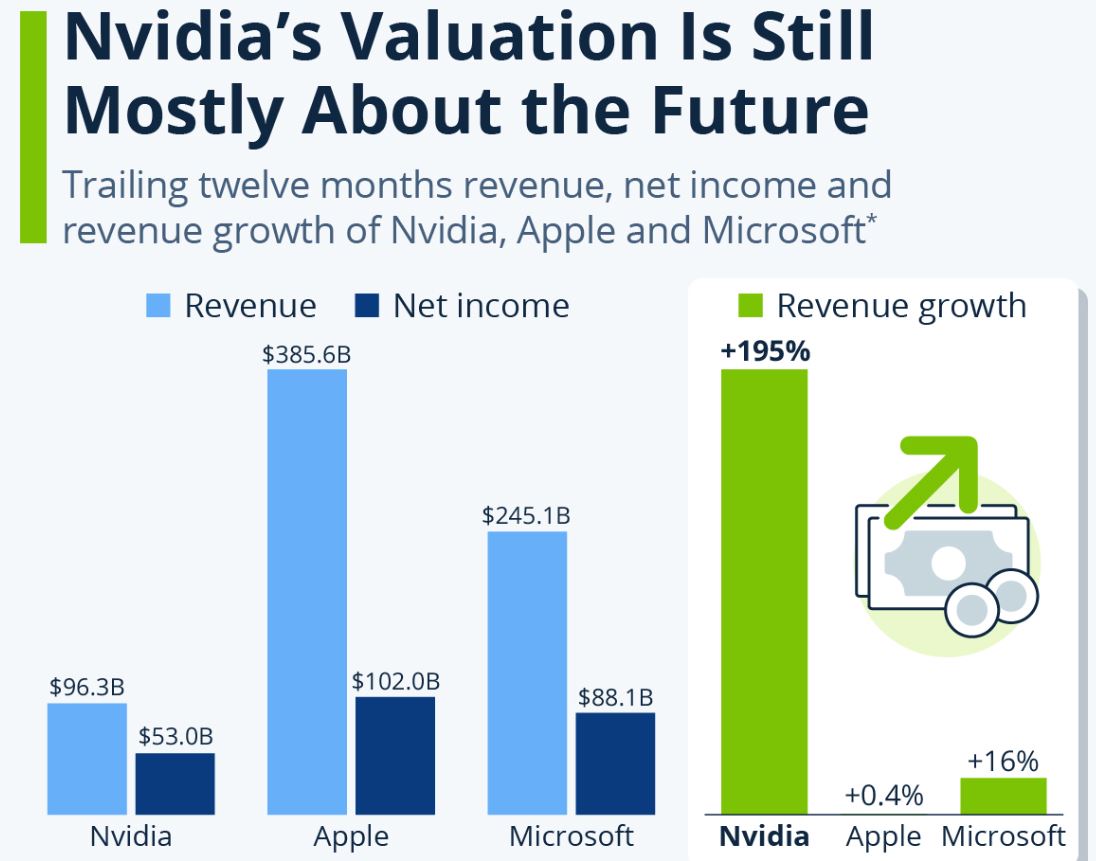
(Source: statista.com)
- As per a Statista report, Nvidia’s US$3T valuation is mostly speculated on future growth, while in fact, the present financials do not back such a valuation.
- Even though the company enjoyed a stellar year for revenue and profits, on the whole, numbers still fall way behind Apple and Microsoft, which have exhibited stable and comparatively higher performances over time.
- Over the last four quarters, Nvidia generated sales of US$96.3 billion, which is just one-fourth that of Apple and about 40% that of Microsoft.
- In net income terms, Nvidia made US$53 billion, putting it just more than half as profitable as Apple and 60% as profitable as Microsoft.
- Its gross margin in the last quarter was 75%, which was better than Apple’s 46% and Microsoft’s 70%.
- Nvidia reported a 195% year-on-year growth in revenues, as compared to almost flat growth in Apple’s revenues and 16% for Microsoft.
- The company anticipates a further 80% rise in revenues this quarter, though the sustainability of this extraordinary momentum of AI chip demand remains to be seen.
Nvidia Market Capitalization
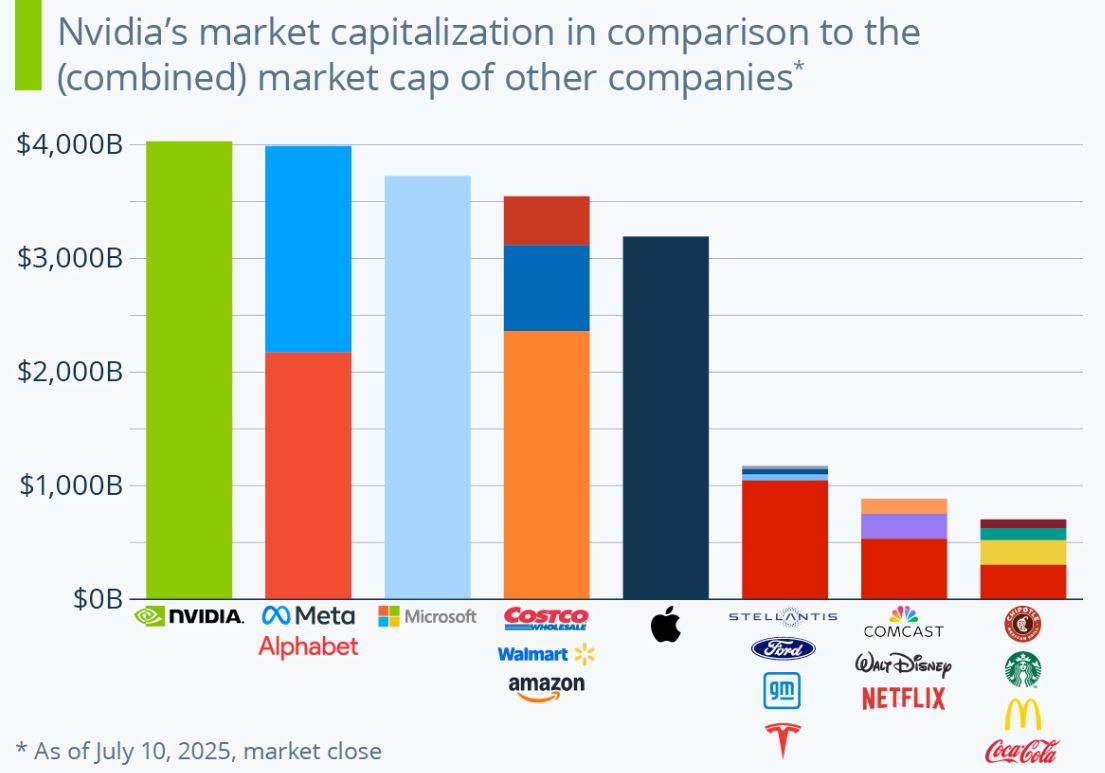
(Source: statista.com)
- A record has been created which states that Nvidia is the first company to close above US$4 trillion in market valuation, toppling Apple and Microsoft, which had for years been much established in the stock market record.
- The company has since seen its stock price put on a meteoric rise, reaching an astonishing 1000% in just about two and a half years, thanks to AI, with Nvidia at the vanguard of this shift in technology as the top chip maker.
- Trying to put this monumental figure into some perspective, Nvidia today is worth more than Microsoft and Apple, with its valuation even outstripping the combined worth of Alphabet and Meta.
- It is also worth more than Amazon, Walmart, and Costco put together, as well as the combined market capitalisation of Tesla, GM, Ford, and Stellantis.
- In the media space, it would take the combined market caps of Netflix, Disney, and Comcast to reach the trillion-dollar mark, while companies of worldwide recognition such as Coca-Cola, McDonald’s, Starbucks, and Chipotle combined account for less than 20% of Nvidia’s valuation.
- The dazzling skyrocketing is the reflection of Wall Street’s profound confidence in the future potential of Nvidia.
- Contrasting views abound: some sceptics warn of a bubble akin to the dot-com bubble, while optimists assert that Nvidia will continue to dominate the AI revolution for years to come.
- For now, Nvidia’s rapid growth from US$750 billion in May 2023 to US$4 trillion has continually turned the sceptics to dust.
Nvidia Quarterly Growth Of Revenue And Net Income
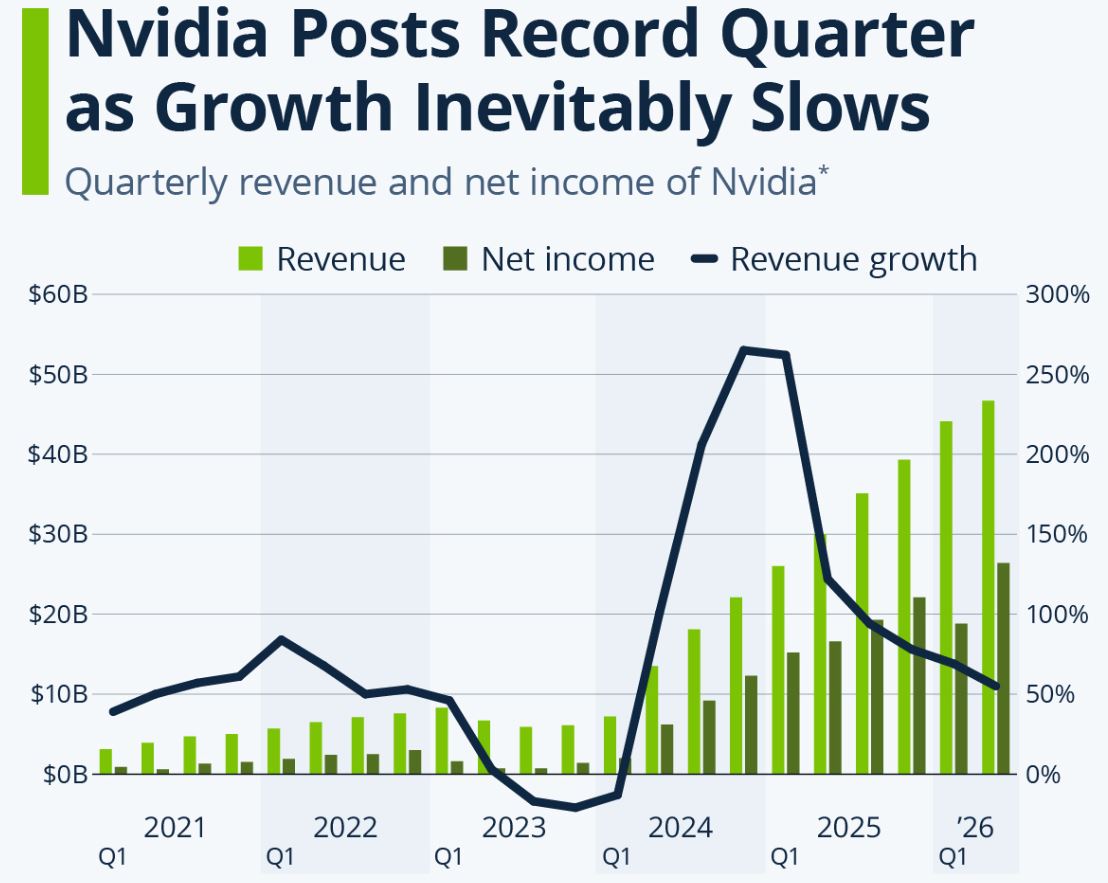
(Source: statista.com)
- Nvidia released its earnings for Q2 of fiscal year 2026 and once again recorded record numbers, even if the pace of growth was showing some tendencies toward slowing down.
- Revenue during the three months ending July 27, 2025, was US$46.7 billion, representing a 55% increase from the same quarter last year and exceeding both the company’s projection of US$45 billion and analysts’ anticipation of US$46.2 billion.
- It was the data centre division that led the show, with heightened AI-related computing demand pushing revenue up 56% year-over-year, accounting for almost 90% of total revenues.
- Net income for the quarter was US$26.4 billion, a staggering figure, six times Nvidia’s profit during the whole of fiscal 2023, before the AI boom.
- Looking ahead, Nvidia projects a revenue of US$54 billion for the coming quarter, another 54% leap from last year’s already lofty baseline.
- While some investors perhaps see growth slowing down from the triple-digit surge of recent years, Nvidia is expanding on a vastly large scale.
- It has already increased revenue six times in the last two years, making an early explosive growth impossible to continue.
- The CEO, Jensen Huang, then addressed the long-term potential, highlighting the reasoning for agentic AI to present the possibility of a US$3 to US$4 trillion AI infrastructure market in the next five years.
- He also brought attention to China as a US$50 billion opportunity for this year, with room for 50% growth annually, despite current trade restrictions.
Nvidia Revenue By Segment
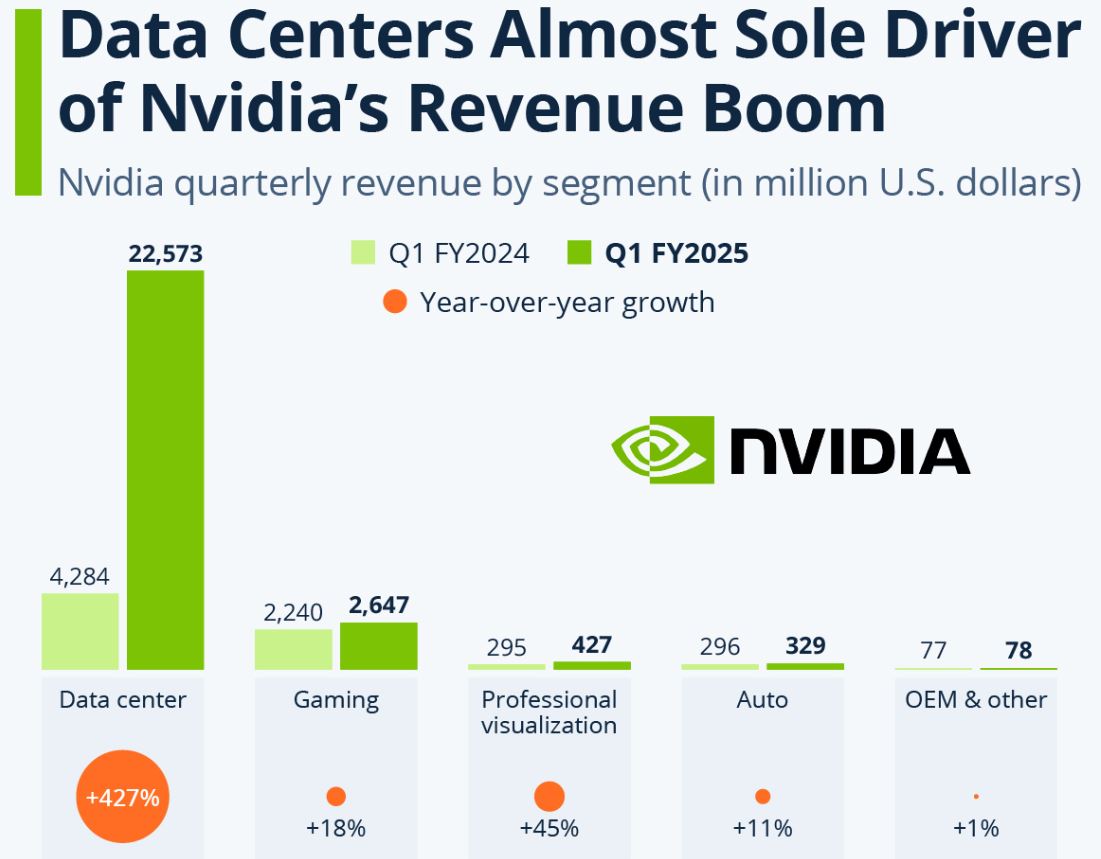
(Source: statista.com)
- Following yet another blockbuster quarter after an already good fiscal Q4 2024, from February to April 2024, the company made revenues of US$26 billion and net income of US$15 billion, smashing analyst expectations by miles.
- This extraordinary growth is chiefly driven by its data center business, supplying chips for artificial intelligence applications.
- In that quarter alone, US$22.6 billion, or 87% of Nvidia’s total revenue, came from data centre solutions, an astronomic 427% year-over-year increase.
- Other segments like gaming and visualisation could also be considered to have grown, by 18% and 45%, respectively; however, these increases seem modest in comparison to the data centre boom.
- The explosion is very much tied to the AI movement that took a great surge after GPT-4 was released by OpenAI in March 2023, which then created a huge demand for specialised AI chips.
- CEO Jensen Huang compared this transformation to the beginning of a new industrial revolution, where “AI factories” have taken on the role of production foundations for artificial intelligence.
- For the longest time, Nvidia was best known for its graphics cards used for gaming, which now account for about a tenth of total revenues.
- The Geforce competitor, AMD, went into a slump. AMD’s gaming revenue fell 48% year-over-year, whilst the data center revenue also went up by 80% but to just US$2.3 billion, little in comparison to Nvidia’s scale.
- Overall, AMD earned US$5.5 billion during the same period, just highlighting how dramatically Nvidia has leapt ahead with AI-powered demand for its chips.
Nvidia Employees
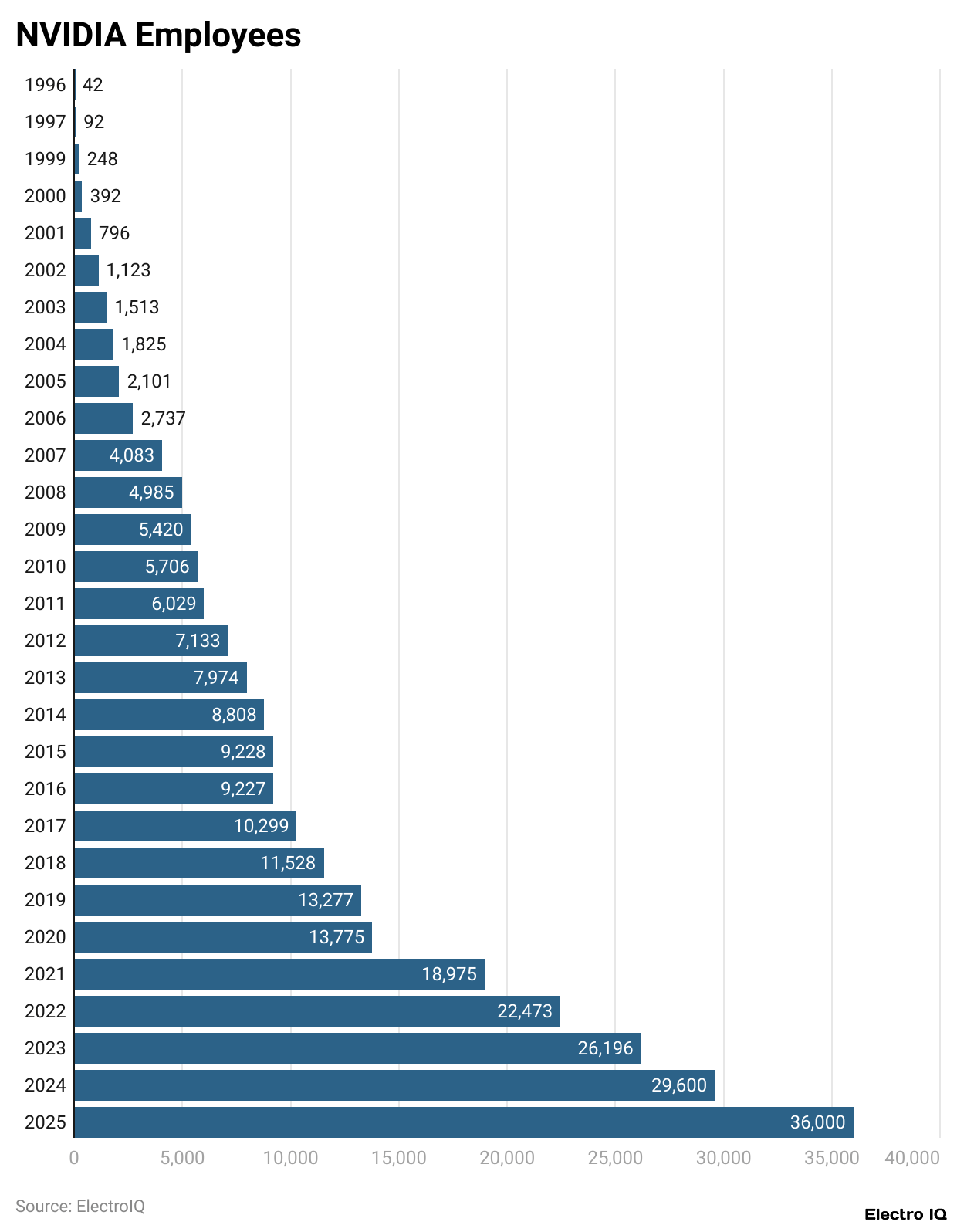
(Reference: statista.com)
- As of 2025, the company employed close to 36,000 persons, representing an increase of 21.6% in employment between 2024 and 2025.
- This kind of growth had never occurred before in the company’s life; since 1996, when the staff numbered only in the handfuls, it has grown 700 times over.
- The workforce remains male-heavy, with about 80% male employees. Then, 55.9% of the employees fall into the Asian or Indian categories, while less than half of them, 49.9%, reside in the Americas.
- The high revenues and profitability of the company also come in par with the high productivity levels of each employee.
- The revenues generated by one employee amount to US$4.1 million, while the profits amount to US$2.1 million for the company.
- In the year 2024, the market cap of Nvidia per employee was about US$102 million, a number that shows how much Nvidia’s workforce is valued by investors and the role it plays in fueling that growth.
Nvidia Research And Development
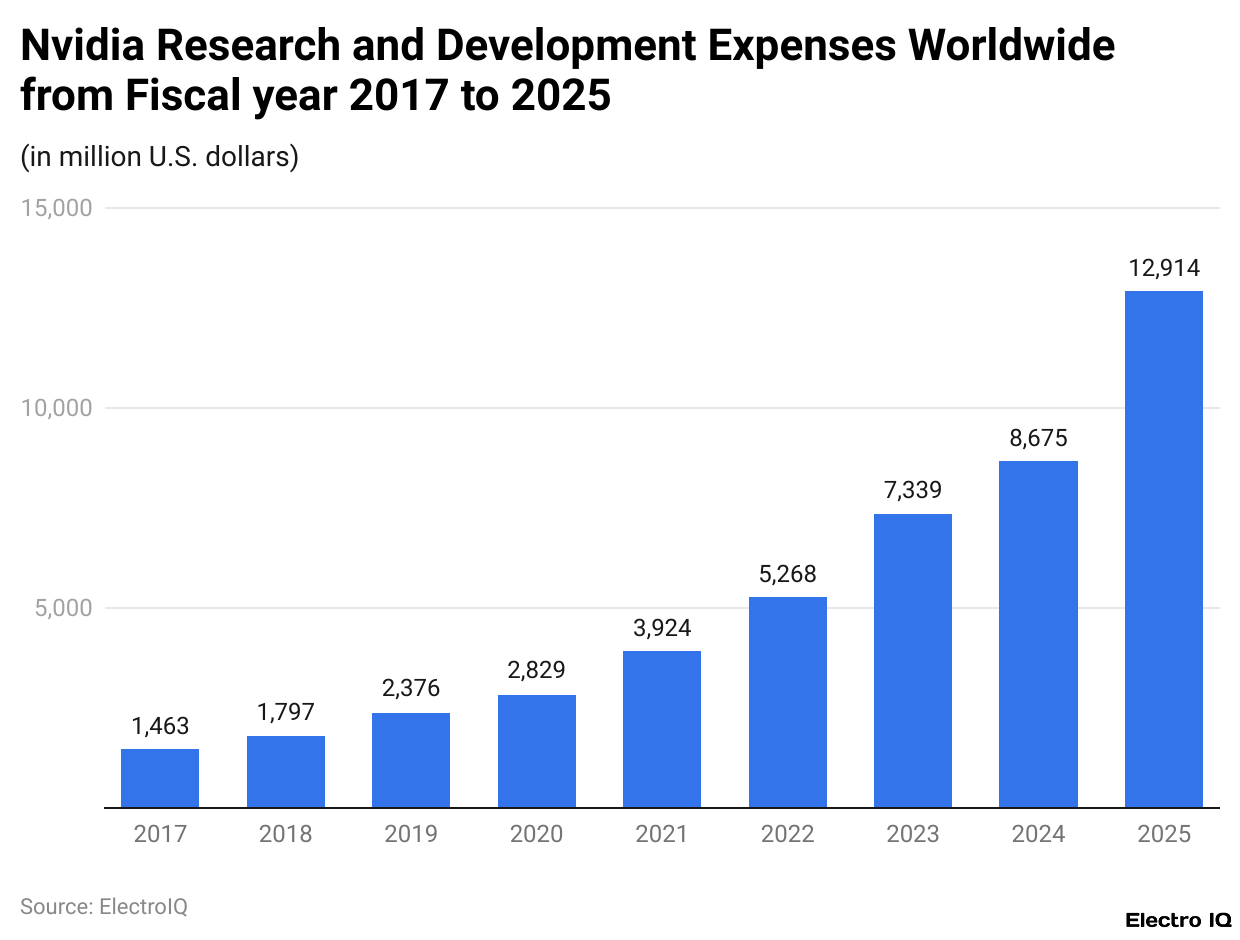
(Reference: statista.com)
- As per a Statista report, Nvidia statistics show that for the past decade, Nvidia has been known for creating jobs in making graphics chips for gaming, with the current CEO Jensen Huang shifting the company to AI as the new core.
- There has been massive demand for data center products from Nvidia that are crucial to running and training AI systems. The infrastructure for ChatGPT was trained and powered by Nvidia.
- Yet, Nvidia is not just competing with its traditional foes: AMD and Intel.
- Currently, big cloud companies, such as Amazon, Microsoft, and Google, are building their own AI chips.
- Thus, this can become a problem for Nvidia, for these companies, if building chips themselves would also keep a hold on its own costs and rely less on Nvidia amid the expansion of the AI chip market.
Nvidia Employees By Location
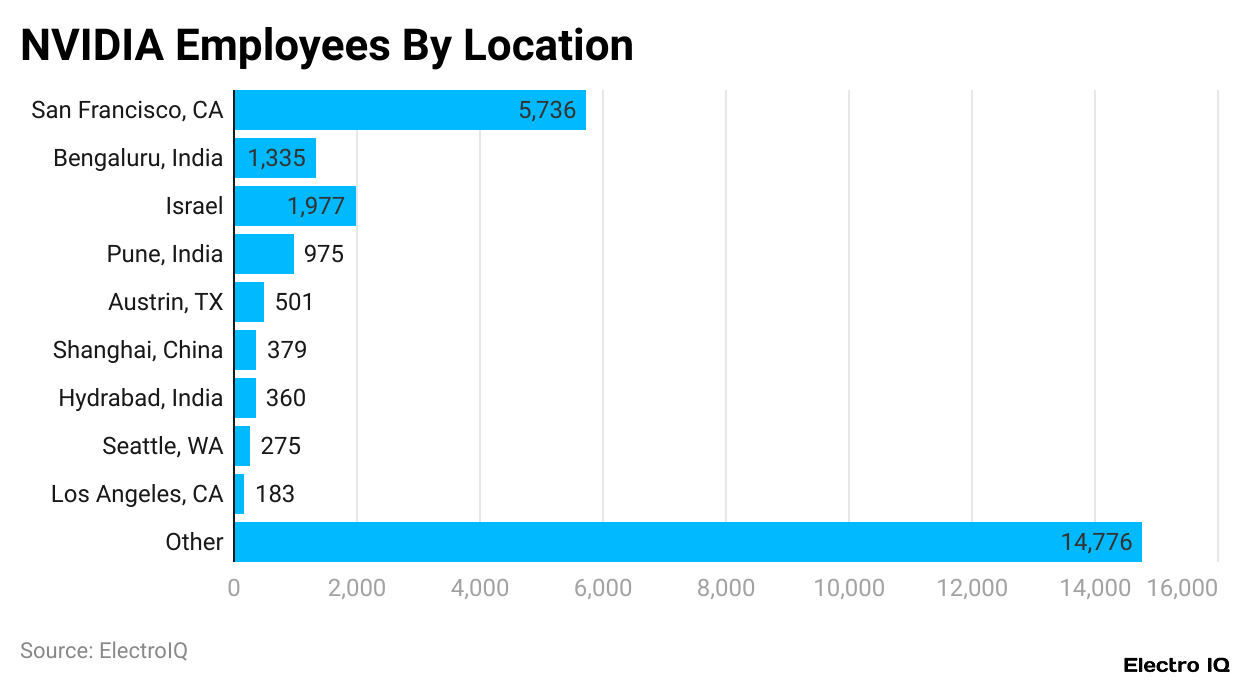
(Reference: electroiq.com)
- In San Francisco, California, Nvidia employs the greatest number of people, with 5,736 employees.
- In Israel, there are 1,977 Nvidia employees, making it the second-biggest locale.
- In Bengaluru, India, 1,335 people work for Nvidia.
- In Pune, India, there are 975; in Austin, Texas, 501; in Shanghai, China, 379; in Seattle, Washington, 360; in Hyderabad, India, 275; and in Los Angeles, California, there are 183 other significant locations.
- Workers numbering 14,776 constitute the bulk of staff in various locations around the world.
Nvidia Workforce By Ethnicity
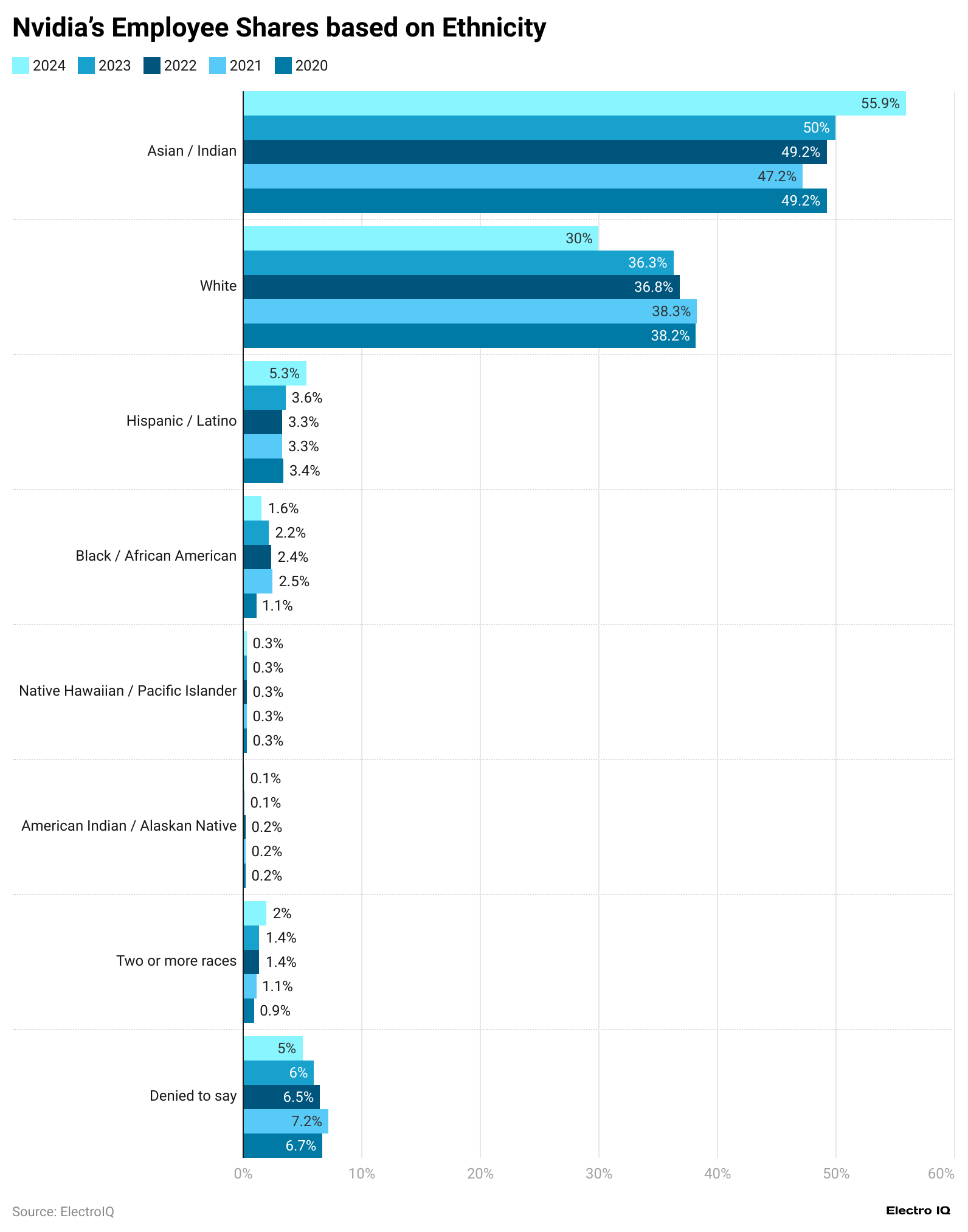
(Source: statista.com)
- These trends show the rise and fall of workforce representation through ethnicities from 2020
to 2023. - It is the Asian/Indian group that has always been the majority: they started with 49.2% in
2020, dipped slightly to 47.2% in 2021, and then rose again to an apex of 50% in 2023. - A gradual decrease over the years has been observed among White employees, from 38.2% in
2020 to 36.3% in 2023. - Hispanic/Latino has remained steady with a slight increase, going from 3.4% in 2020 to 3.6%
in 2023. - There was a great surge for Black/African American employees in 2021 to 2.5%, but a slightThe
drop took place in 2023 to 2.2%. - Native Hawaiian/Pacific Islander and American Indian/Alaskan Native employees have
maintained consistently low counts of approximately 0.3% and 0.1-0.2%, respectively. - Finally, those refusing to disclose their ethnicity have ranged between 6% and 7%, trending
downward. - Slowly but with some visible change, the numbers show that Asian/Indian representation has
Grown and White employee counts have declined.
Stock Volatility And Trading Volume Data
- In 2025, excellent liquidity and investor interest were seen in Nvidia-common shares (NVDA), in which an average of more than 41 million shares were traded every day.
- This figure would go up to 60 million on the days of earnings release for NVDA.
- Its options market is also highly active, with implied volatility of 45%, higher than other companies like AMD and Intel, and the historical volatility being steady at 28%, compared to the highs seen during the pandemic.
- NVDA ranks in the top five most traded stocks on Nasdaq by dollar volume every year, and its options were the most trade-worthy ones in the Tech space in 2024.
- Bullish put/call ratios paint a positive picture for the firm’s sentiment, while a beta figure of 1.29 puts it on the steadier side.
- More than 55% of daily volume comes from algorithmic trading, while 6-8% price swings get witnessed after earnings announcements, indicating upcoming price sensitivity seen towards a certain guidance.
| Year | EPS |
| 2,024 | US$11.93 |
| 2,023 | US$1.74 |
| 2022 | US$3.85 |
| 2,021 | US$1.73 |
| 2,020 | US$1.13 |
| 2,019 | US$1.66 |
| 2018 | US$1.21 |
| 2017 | US$0.64 |
| 2016 | US$0.27 |
| 2015 | US$0.28 |
| 2014 | US$0.19 |
| 2013 | US$0.23 |
| 2012 | US$0.24 |
| 2011 | US$0.11 |
| 2010 | US$-0.03 |
| 2009 | US$-0.01 |
(Source: investing.com)
- Earnings per share show how much profit a company makes for each share of stock. It is calculated by dividing total earnings by the number of shares.
- For Nike, diluted EPS for the quarter ending January 28, 2024, was recorded at US$4.93, showing an enormous 765% increase compared to the same quarter in 2023.
- Looking at the full year, Nvidia’s 2024 annual EPS of US$11.93 witnessed a monstrous 585.6% jump over 2023.
- Back in 2023, the company’s EPS had fallen to US$1.74, which was a 54.81% direct decrease from 2022.
- Simply put, Nvidia’s earnings per share fell in 2023 but then exploded in 2024, underscoring the rapid gain in earnings power it has undergone with the AI boom.
Nvidia Stock Price
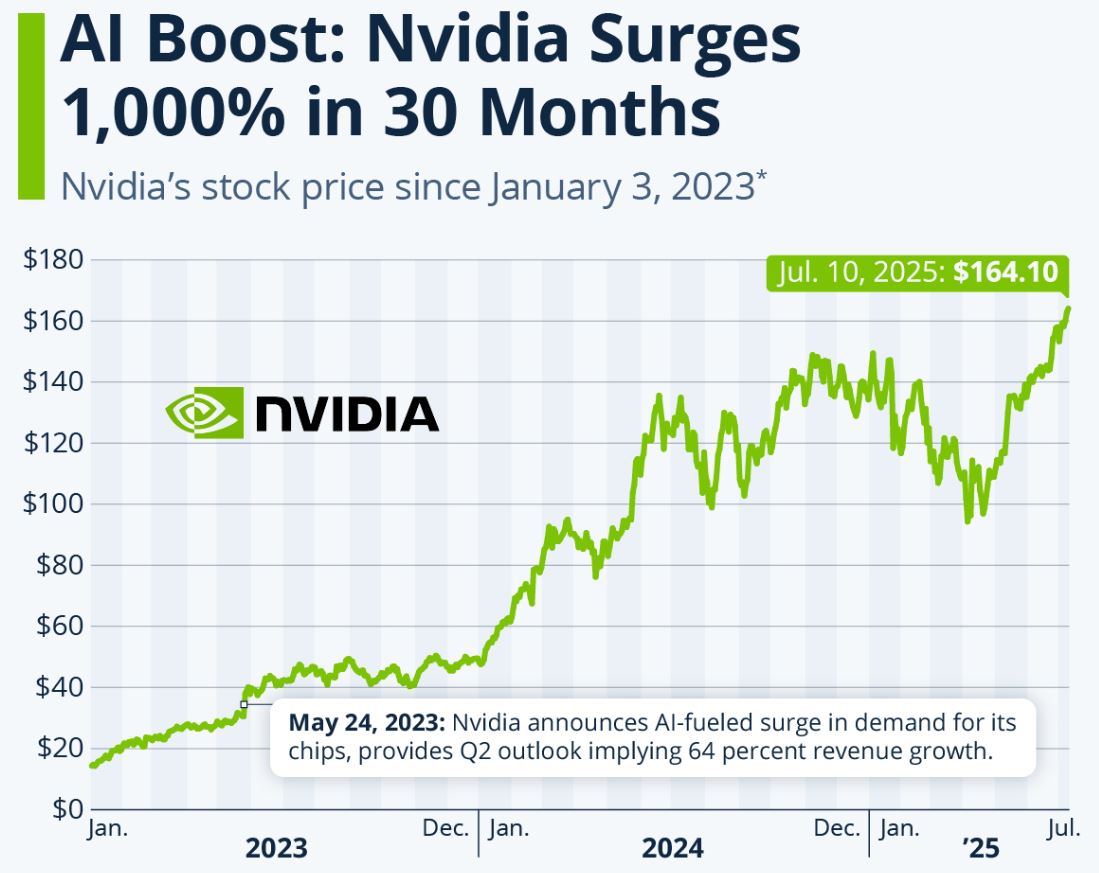
(Source: statista.com)
- Nvidia’s fast ascent to being the world’s most valuable company was fueled spectacularly by the AI boom.
- A popular meme tells the story of Nvidia as a guy selling shovels during a gold rush, as opposed to Microsoft, Alphabet, and Meta, which are portrayed as gold diggers.
- In other words, Nvidia is selling the critical chips—the “shovels”—needed to fuel AI, making it the most crucial chip supplier of this new age of computing.
- Since Nvidia CEO Jensen Huang flagged the enormous AI opportunity for the company in May 2023, its share price has zipped upwards.
- NVIDIA’s share price has been up 437% from May 24, 2023, to July 10, 2025, and it is up more than 1,000% from January 2023, with a US$4 trillion market value.
- The share price witnessed many sharp ups and downs, especially in the past year. Investors speculated whether sky-high pricing over US$3 trillion could be justified and if there really was any room left for growth.
- The January 2025 sell-off was huge, triggered by speculation that DeepSeek-R1 could perform AI results with fewer Nvidia GPUs. Further announcements of tariffs in March and April upended the stock again.
- The share price went to its lowest, at US$94, just after Trump’s Liberation Day speech on April 4, 2025.
- The stock has recovered with full force, climbing 74% to end at a record-high of US$164.1, bearing testimony to an ultrafast recovery from any challenges.
Nvidia Major Acquisition
- In 2022, Nvidia acquired Bright Computing, which develops software to manage the lifecycle of high-performance computers, thus aiding Nvidia in growing its AI and data center business.
- In 2021, it acquired DeepMap, a startup building high-precision maps for autonomous vehicles, to advance its DRIVE platform for autonomous vehicles.
- The year 2020 saw two major acquisitions by Nvidia: purchases of Cumulus Networks, makers of open networking software for data centers, and of Mellanox Technologies, an Israeli chip design firm, for a total of US$7 billion.
- The acquisition of Mellanox, one of the largest transactions by Nvidia, provided the stimulus for performance in data centers.
- Earlier on, Nvidia made a few smaller buys: Icera in 2011 (US$367M; baseband/RF technology), PortalPlayer in 2006 (US$357M; audio technology), MediaQ in 2003 (US$70M; chipmaker), and the graphics assets of 3dfx Interactive in 2002 (US$70M plus stock).
- It also bought Hybrid Graphics in 2002 in the quest for mobile and embedded graphics.
- In simple terms, Nvidia turned almost from a graphics chip company into areas of AI, data centers, self-driving cars, and networking technology, on which the present foundation of the company rests.
Nvidia Awards
- In 2023, Nvidia was named the best workplace by Glassdoor on the basis of employee reviews, whereas Comparably, far and away, gave it the accolade of “Best Company Culture” for building an incredible work environment.
- In 2021, Fast Company ranked Nvidia as the third most innovative company, with Forbes’s Just 100 list naming it second-best Corporate Citizen, behind only Microsoft.
- Nvidia is famed for its emphasis on great workplace values. It was named by MIT Sloan and Glassdoor in 2020 as a Culture Champion.
- Dow Jones also considered Nvidia the Best Green Company for its environmentally conscious practices.
- While being recognised in 2018 for channelling its technology for social and humanitarian aid projects, earlier in 2015, Nvidia received a PACE Award for the Tegra Visual Computing Module that kept car infotainment systems modern and updated.
- On the flip side, the leadership of Nvidia also received some limelight: The Harvard Business Review ranked Huang as one of the Best CEOs in 2019 and 2023 for his leadership.
Nvidia’s Strong Financial Health
- Nvidia’s financials reveal that the company runs very efficiently and has created a very strong balance sheet.
- It became able to price its operating margin at 52% in 2025, well above the semiconductor industry average. This is proof that it has the ability to convert revenue into profit.
- With an ROIC of 48%, Nvidia is putting the money of its shareholders to very good use.
- On the other hand, its asset turnover of 0.94 highlights the fact that it can generate high revenue with many assets.
- A net profit per head of US$1.6 million implies that the workforce is very valuable.
- This is an operationally very lean company, as SG; expenses have gone down to 7.8% of revenue, with inventory turnover remaining steady at 3.2 times; and with days sales outstanding (DSO) being at 28 days, it allowed faster collection of cash.
- On the other side, R&D spending of around 12% of revenue keeps the balance between innovation and profit.
- Revenue growth outrun expenses, so margins increase more. Also, the NVIDIA AI Enterprise software stack now provides recurring revenue alongside hardware.
- On the balance sheet, however, the company carries US$36 billion in cash and nearly no long-term debt, with a debt-to-equity ratio of less than 0.1.
- Total assets amount to US$94 billion, and it has a current ratio of 3.1, thus making it very solvent and liquid.
- While shareholder equity is worth more than US$56 billion, net cash stays above US$25 billion after hefty capital expenditure.
- This financial standing enables Nvidia to carry out acquisitions, fund buybacks, and invest in growth all without worthy risks.
- Talking of the agency side, the strong cash flows and low leverage were key determinants behind the reaffirmation of the AA+ rating in 2025.
Nvidia Actual And Expected Earnings
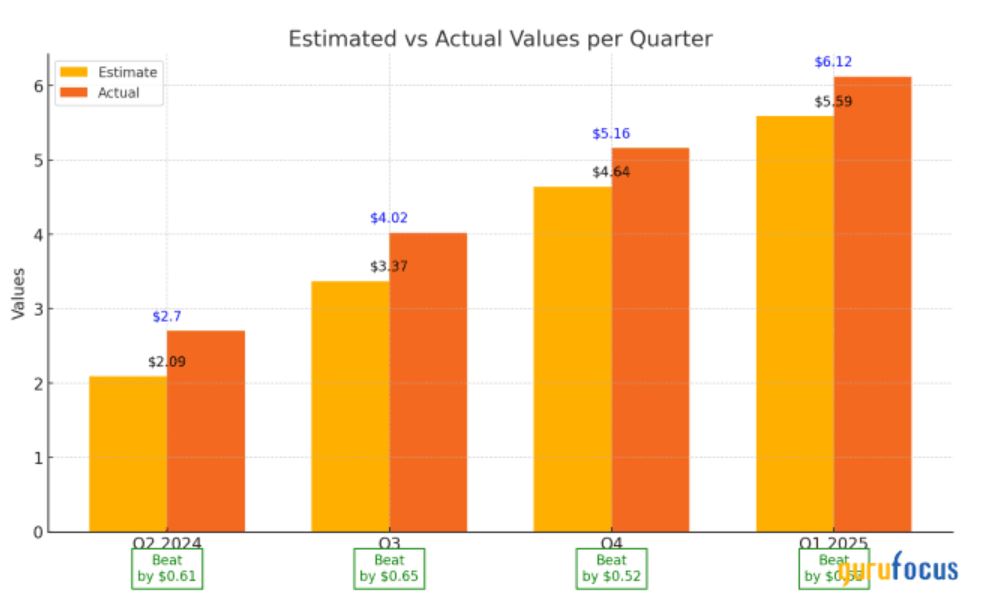
(Source: coinlaw.io)
- As per Coinlaw, Nvidia statistics show that this quarter-on-quarter surge in earnings momentum has been visible in Nvidia’s quarterly earnings results from Q2 2024 through Q1 2025.
- In Q2 2024, earnings per share amounted to US$2.70, US$0.61 above the Wall Street estimate of US$2.09.
- This trend continued in Q3 2024 as earnings hit US$4.02, US$0.65 above the US$3.37 expected.
- Earnings per share of US$5.16 again beat the US$4.64 expected by US$0.52 in the quarter ended December 2024.
- In the last quarter of this streak, Q1 2025, the company reported US$6.12 per share, beating estimates of US$5.59 by 53 cents.
- This steady performance marks Nvidia’s streak of better-than-expected earnings reports.
Institutional Vs. Retail Ownership
- By 2025, nearly 71.5% of Nvidia shares are said to be owned by institutions, including such names as Vanguard, BlackRock, and Fidelity, each holding in excess of 5% of shares.
- Retail trader patronage stands almost tall, with Nvidia being among the top three most-held stocks on retail platforms like Robinhood and eToro.
- Since its establishment, the company’s investor base has grown worldwide, with sovereign wealth funds from countries like Norway and Singapore increasing their stakes.
- Passive investment demand has been aided by Nvidia, now included in major ETFs such as QQQ, VTI, and SOXX. Over 40 investor roadshows were held by Nvidia in 2024 to maintain close ties with its large investors.
- On the retail side, individual investors have returned. There have been spikes in trade volume as individual investors react to an earnings beat.
- Simply stated, it has entirely swollen to over 1.3 million stockholders, with its solid ESG ratings attracting sustainability-focused funds.
- The company maintains dividends paid annually at US$0.16 per share, a figure that has not changed in years and implies a yield of less than 0.1%.
- Rather than rewarding shareholders with higher dividends, the company favours its share repurchase programs as the main method of returning value to stockholders.
- During 2024 alone, Nvidia bought back over US$12 billion in shares and authorised an additional US$25 billion buyback program in March 2025.
- So far during the past year, buybacks reduced shares outstanding by close to 2.8%, resulting in a higher EPS.
- The large cash reserves give Nvidia substantial capacity to continue buybacks without having to incur debt.
- The company usually makes use of dips in the market to buy shares at cheaper prices.
- The payout ratio of the company remains under 5%, with the company opting to reinvest profits mainly in research and development and capital expenditure.
- Still, analysts feel that, once revenue growth stabilises, the company should slowly start ramping up its dividend payments in 2025.
NVIDIA Insider Confidence And Strategic Growth Highlighted
- The top executives of NVIDIA are buying more shares in the company for prices lying between US$450 and US$475, thereby showing strong confidence regarding its future performance.
- Insider purchases of this sort may imply that the interests of the leadership are well aligned with those of shareholders, thus building investor trust.
- Moreover, as far as strategic initiatives are concerned, NVIDIA maintains its leadership in the industry.
- Acquisitions such as that of Mellanox for enhanced networking capabilities and ARM for fine-tuning advanced chip architecture have given a broader face to the company and reinforced deeper vertical integration.
- Its collaborations with the biggest cloud providers, such as Microsoft and Amazon, are giving a solid push to its data centre business.
- The very corollary of that line of thought is an NDA’s provision that legally rather than forcibly bars any competitor from contesting that innovation.
- Therefore, support from NDA keeps the core NVIDIA Business in one piece.
- An intermingling of insider confidence, strategic acquisitions, alliances, and focused R&D spending will continue to provide NVIDIA a dominant force in the market.
NVIDIA’s GPU Roadmap
- Among other things, NVIDIA considerably accelerates the development of its GPU products, following a rapid release cadence that Big Tech has always endowed with capital expenditures in return for performance, energy efficiency, and TCO improvements.
- The GTC saw CEO Jensen Huang unveiling Blackwell Ultra, the next-generation product family, including GB300, Vera Rubin, Vera Rubin Ultra, and Feynman, an initial glimpse at Rubin’s successor.
- The GB300 NVL72 comes in the second half of 2025 and brings a 1.5× lift over the GB200 generation; it packs 50% more FP4 dense compute and yet 50% more memory capacity to increase inference throughput significantly.
- Rubin NVL144, arriving in late 2026, is stated to be “drop-in compatible” with Blackwell systems and delivers a 3.3× increase in FP4 inference performance, said to reach 3.6 exaFLOPs per chip.
- Likewise, it will be upgraded to HBM4 memory with 288 GB capacity remaining and will provide a 50-petaFLOPs FP4 performance per chip against only 20 petaFLOPs in Blackwell.
- Rubin Ultra NVL576, set for launch sometime in the latter half of 2027, promises the biggest of all jumps and offers 15 exaFLOPs of FP4 inference performance-a 4× leap from Rubin and nearly a 14× leap over GB300 within just two years.
- This very aggressive roadmap will help lay the foundation for NVIDIA to own the US$1 trillion datacenter GPU market.
Recent Developments
- In early 2025, several moves by Nvidia had an impact on its stock. It launched the Blackwell GPU platform, with the intent to train AI models faster and with less energy.
- Another multi-billion-dollar partnership with Samsung and TSMC was founded to manufacture 3nm GPUs, thereby strengthening its manufacturing capacity.
- In January 2025, Nvidia acquired a robotics software company, thus entering the autonomous systems market.
- On the software side, Nvidia integrated generative AI services into its Omniverse platform, thus increasing its footprint in AI applications.
- The company secured long-term GPU supply agreements with Microsoft, Oracle, and AWS to ensure strong revenue growth in the coming years.
- In tandem, it grew its investments in edge AI and automotive computing, creating fresh revenue streams.
- Regulatory approval for expansion via joint ventures in China relieved some geopolitical hurdles, allowing the company to grow further on an international scale.
- Furthermore, the company launched a carbon-neutral initiative for its data center products, making it even more attractive to green investors.
- Until now, NVIDIA has enriched its partnerships with universities to promote AI research, thereby securing talent and discoveries.
- The company also released a beta version of Nvidia Cloud Studio, a creative suite for content developers and AI creators, which shows that the company is venturing further into software, beyond solely being a hardware-oriented company.
Conclusion
Nvidia Statistics: An extraordinary transformation indeed, from being a gaming GPU maker into one of the global AI powerhouses. The 2025 results reflect record revenues, profits, and a US$4 trillion market cap, largely driven by the booming data center and AI chip segment. Financial strength, along with heavy R&D investments and strategic acquisitions, in effect, keeps Nvidia competing at the top of innovation.
Productivity of its employees, lean operations, and revenue growth, along with a streak of earnings, underscore the company’s resilience. Increasing software offerings, followed by generative AI project teams and international partners, will keep Nvidia atop AI infrastructure, rendering it a central figure in technological changes.
FAQ.
By 2025, Nvidia had reached a market capitalization of US$4 trillion, by overtaking Apple and Microsoft. This ascent goes hand in hand with all the rapid growth in AI and data centers, allied with high earnings and so much investor confidence that its stock price has gone up over 1,000% since January 2023.
Data center solutions are the main source of revenue for Nvidia, producing 87% of total revenue in Q4 2024. This area is responsible for AI-related computing, with soaring growth of over 400% YoY in certain quarters, thus resulting in the meteoric rise in the company’s base financials.
Over the past four quarters, Nvidia’s revenues amounted to US$96.3 billion, while its net income reached US$53 billion. It has an operating margin of 52%, an ROIC of 48%, and generates US$4.1 million in revenues and US$2.1 million in profits per employee, underscoring operational efficiency and high profitability.
In 2025, Nvidia launched the Blackwell GPU platform, expanded generative AI use cases within Omniverse, partnered with Samsung and TSMC for 3nm GPUs, and ventured into robotics and edge AI markets. Additionally, the company unveiled Nvidia Cloud Studio for AI-assisted content creation.
Nvidia gives a small yearly dividend of US$0.16 per share, but the main focus remains on share buybacks, with US$12 billion in repurchases planned for 2024 and another US$25 billion authorised in 2025. This strategy drops shares outstanding, rises earnings per share, and makes use of the ample cash reserves without incurring debt.

I hold an MBA in Finance and Marketing, bringing a unique blend of business acumen and creative communication skills. With experience as a content in crafting statistical and research-backed content across multiple domains, including education, technology, product reviews, and company website analytics, I specialize in producing engaging, informative, and SEO-optimized content tailored to diverse audiences. My work bridges technical accuracy with compelling storytelling, helping brands educate, inform, and connect with their target markets.










